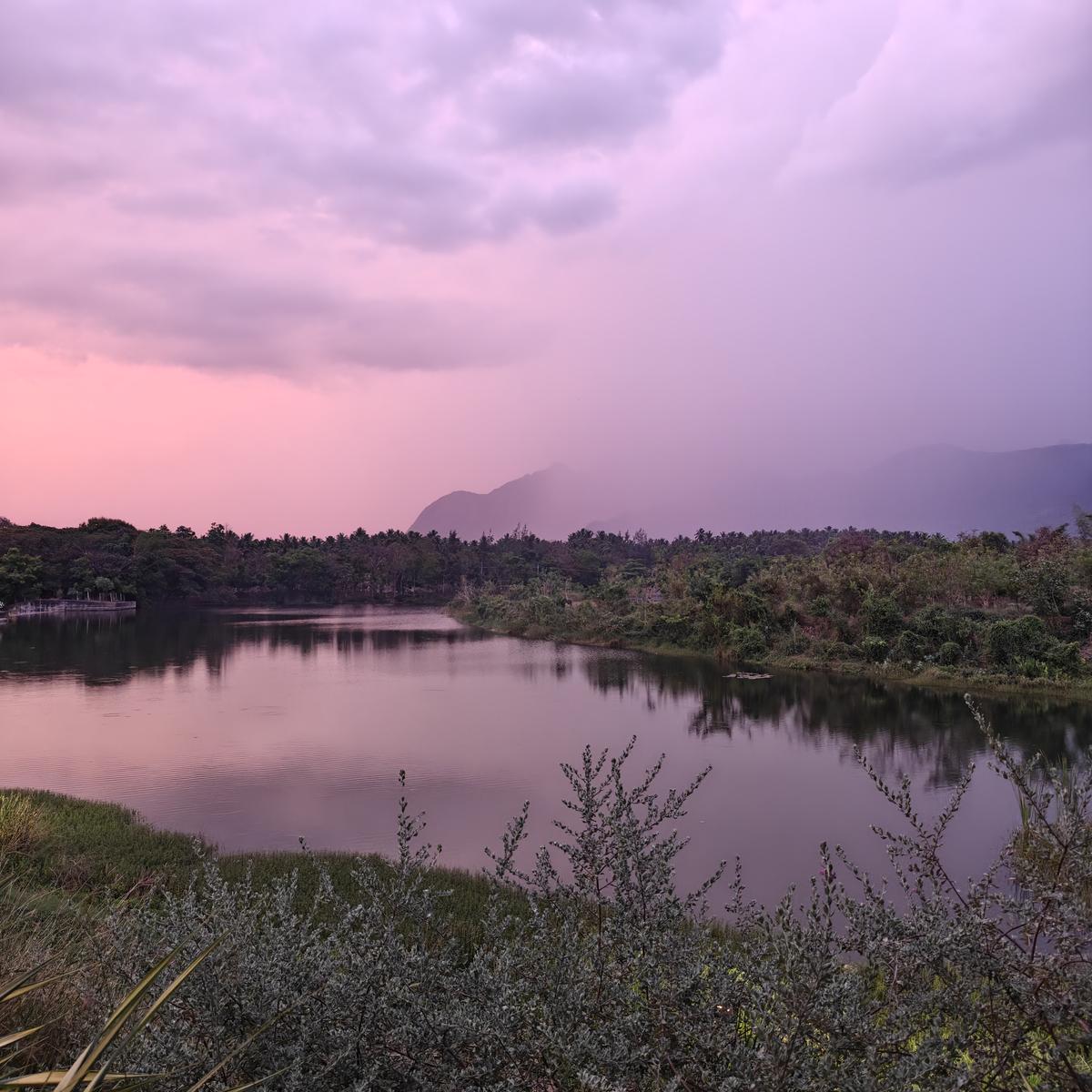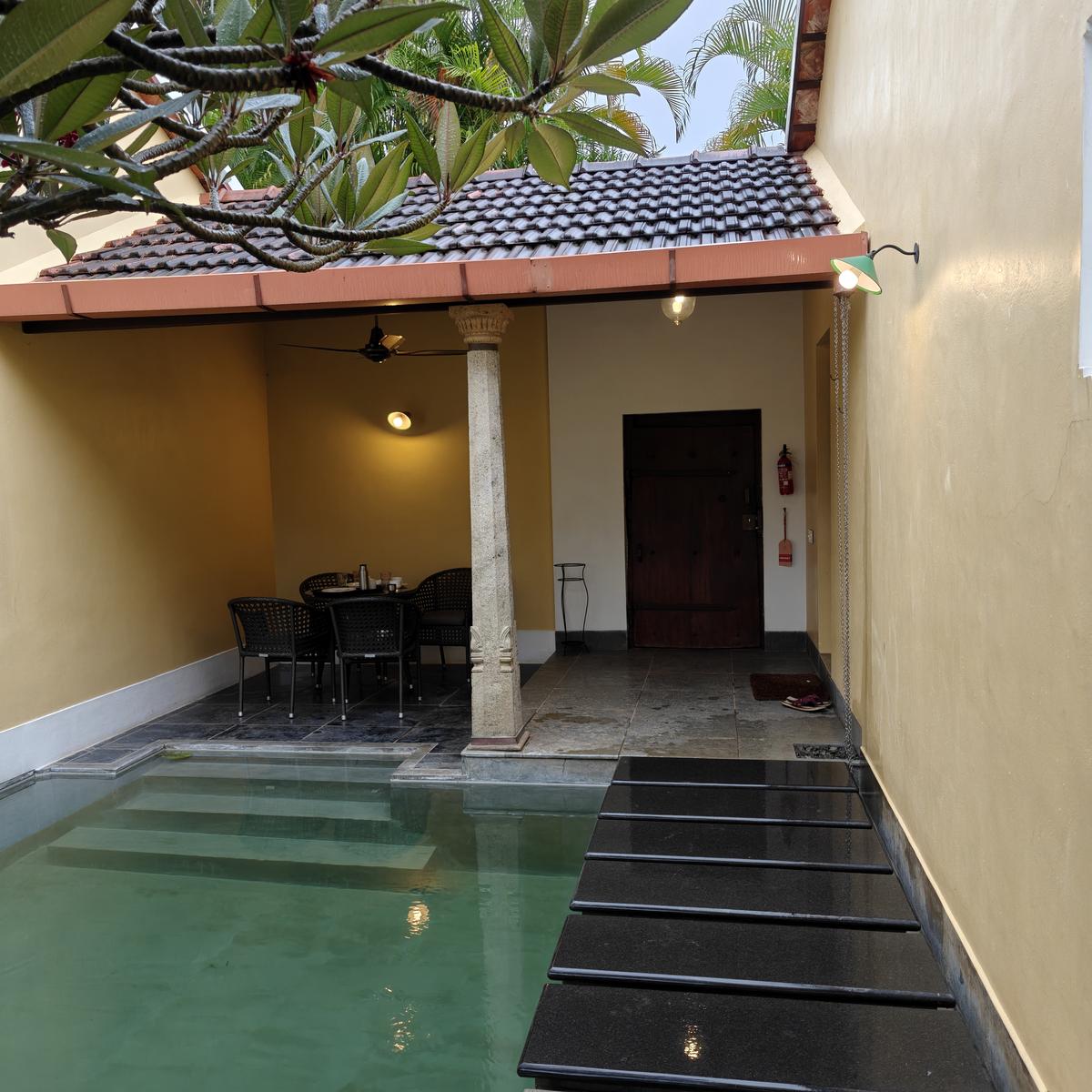
The property is surrounded by lush greenery
| Photo Credit: Special Arrangement
The picturesque Western Ghats bathed in pastel pink hues at twilight, and an absolute calm form our first impression of Dvara Siruvani. Before we get to the property, which is an hour’s drive from the city, we stop by for a satisfying lunch at Rasanai with Kongu kozhi thanni rasam, a fiery chicken soup, followed by a line-up of chicken biryani, and the impressive Sivaji Nagar military hotel mutton chops, rounded off with mango pudding for dessert.

Western Ghats bathed in pastel pink hues. Shot on oneplus #frames of India
| Photo Credit:
K Jeshi
Once at Dvara, I sip my welcome drink and watch the mighty hills and the forests take on a many colours. There are 16 cottages that include mountain view, private infinity pools and garden view. Each cottage is named after native flowers likekonrai, vaagai, parijatham to name a few. I bow down to enter my cottage named Kurunji through an artistically carved door that once graced a Chettiar home in Karaikudi. Short in stature, such doors encouraged the tradition of bowing while entering a home to show its inhabitants respect and humility. A private garden opens into stunning views of the Western Ghats and copious waters of the Noyyal flowing into the Mundanthurai check dam. Heirloom furniture including a wooden poster bed, Tanjore glass paintings and aesthetic artefacts compliment the interiors. An infinity plunge pool adds to the luxury.

“The property was a bit of an accident,” recalls Vikram Mohan, chairman of Pricol group that runs Dvara. “The property evolved from a desiliting project to an outbound training centre with tents. Later, my wife Lakshmi and I developed Dvara as a labour of love. We both are collectors of South Indian antiquities for many years, from old Kanjivaram saris and Ravi Varma prints to old vengalapitalapathram, kadarams, thengaithuruvis and kavadis. Our bed runners feature paaavadai davani designs in multiple colours. Lakshmi’s collection of her grandmother’s saris became the beds’ backdrop. We celebrate all things South Indian, Tamil heritage and conceptualised the property as a throwback to visiting homes in villages complete with Kongunadu samayal.”
Every corner at the property unravels cultural memorabilia. Old utensils, South Indian antique artefacts, Tanjore paintings and enamelware peek through the common areas that have an old world charm. An antique chest at the reception is stunning.

An infinity plunge pool adds to the luxury. Shot on oneplus #frames of India
| Photo Credit:
K Jeshi
“Some of the urulis displayed bear the cross on them indicating that they have been used in Christian households to make payasam. We added details like ergonomically designed thinnai, oonjal, and vilakkumaadam to replicate village life. While the doors tell stories of humility and a method of self-defence, the AshtaMangalam mural is indicative of qualities one needs to have to lead a good quality life. There is abundant greenery and the entire landscaping credit goes to my wife. We added Pollachi rekla vandi, and terracotta horses (crafted by a potter from Tirunelveli) to the garden decor. It’s more like a virunthombal experience.”
At dinner time, Chef Arul and his team lay out fluffy idiyappamidlis and creamy chicken stew. After a round of sulaimani, we call it a day. At the crack of dawn, along with M Rajesh, an in-house naturalist, we walk past bougainvillea and jasmine blooms, yellow trumpet trees and Rangoon creepers with red flower clusters for a trek to the foothills of the Western Ghats. Along the way, we spot a purple sunbird, an Oriental darter sunbathing with its wings spread out on a tree top, while the colourful Indian Pita whistles away and the common hawk-cuckoo sings repetitively.

Short grain rice flavoured with betel leaves and fried garlic. Shot on oneplus #frames of India
| Photo Credit:
K Jeshi
Lunch at Aarogyam, the in-house restaurant, showcases delicious Kongu cuisine. We try the aromatic Keeranur chicken biryani, bun parotta with Kongunadu mutton kuzhambu and vethalai poondu saadam, short grain rice flavoured with betel leaves and fried garlic. As a culinary anthropologist, Vikram has been studying the history of food of Peninsular India and that’s how he introduced Kongu cuisine.
“It’s all about the nuances of flavours. For example, betel leaf has a strong taste and how that imparts a dish or garlic when it’s slightly roasted without curry. In Pollachi mutton kuzhambu, the flavouring comes from drumstick used in the curry. In villages around Karur, there is sorakkai thattaipayir saadam eaten with vaalaithanduthayir pachadi,” explains Vikram adding that he also picked recipes like asari kozhi varuval, endemic to the region. “There is something called porial podi made with six ingredients like coriander seeds, fenugreek, dry chillies, channa dal, urad dal, and a hint of black pepper, coarsely ground. A pinch of asafoetida gives the umami flavour.”

After a relaxing foot massage at the spa, I sit by the thinnai and gaze at the mountains, content and happy
To know more, visit dvara.in or call 7339111222
Published – June 19, 2025 02:44 pm IST